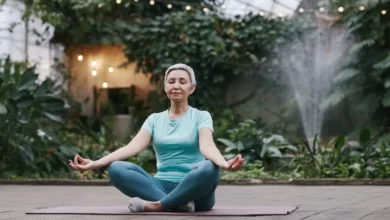In the midst of life’s hustle and bustle, finding a moment of calm and clarity can feel like a rare luxury. However, the practice of mindful meditation offers a pathway to cultivate inner tranquility and presence in the midst of chaos. Mindfulness meditation isn’t just about sitting in silence; it’s about training your mind to be fully engaged in the present moment, fostering a sense of peace and resilience. In this article, we will explore various mindful meditation techniques and provide you with the tools to embark on a journey towards a calmer, more centered self.
1. Understanding Mindful Meditation
In a world where distractions are abundant, mindful meditation offers a refuge of calm and presence. It’s about more than just sitting still; it’s a practice that invites you to become fully aware of the present moment, letting go of past regrets and future anxieties. Mindfulness meditation encourages you to observe your thoughts and emotions with non-judgmental awareness, fostering a deep sense of inner peace.
2. Why Mindful Meditation Matters
Mindful meditation is more than a passing trend; it’s rooted in ancient wisdom and has been scientifically proven to offer a multitude of benefits. From reducing stress and anxiety to enhancing emotional regulation, mindfulness positively impacts both your mental and physical well-being. It allows you to connect with yourself on a profound level and promotes a sense of harmony with the world around you.
3. Preparing Your Meditation Space
Creating the right environment for meditation is crucial. Choose a quiet and clutter-free space where you can immerse yourself in the practice. Comfortable seating, whether it’s a cushion or a chair, is essential to ensure you can maintain focus without physical discomfort. Elements like calming colors, natural light, and soothing scents can contribute to a serene atmosphere.
4. The Basics of Mindful Meditation
Mindful breathing serves as the cornerstone of this practice. Focusing on your breath anchors you to the present moment, allowing you to let go of mental chatter. As thoughts arise, acknowledge them without judgment and gently guide your attention back to your breath. Through this process, you cultivate a state of mindfulness – a heightened awareness of the here and now.
5. Body Scan Meditation
The body scan meditation is a powerful technique for grounding yourself in the present moment. By systematically bringing your attention to different parts of your body, you create a connection between your mind and your physical sensations. This practice helps release tension and stress, promotes relaxation, and nurtures a deeper understanding of your body’s signals.
6. Guided Meditation
Guided meditation offers a structured approach for beginners and a refreshing experience for experienced practitioners. Expert instructors provide verbal guidance, leading you through various themes such as gratitude, self-compassion, or visualizations. Guided meditation apps and online resources offer a wealth of options, allowing you to explore different styles and intentions.
7. Walking Meditation
Meditation doesn’t have to be confined to a stationary position. Walking meditation involves moving mindfully, synchronizing your breath with your steps. This practice heightens your awareness of your body in motion and deepens your connection with your surroundings. It’s a way to integrate mindfulness into your everyday movements, whether indoors or outdoors.
8. Loving-Kindness Meditation
Loving-kindness meditation, also known as Metta, is a heart-centered practice that nurtures compassion. By cultivating positive feelings toward yourself and others, you expand your capacity for empathy and connection. Through the repetition of affirmations, you send out well-wishes and positive intentions, creating a ripple effect of goodwill.
9. Mindfulness in Daily Activities
Mindfulness doesn’t have to be confined to formal meditation sessions. You can infuse mindfulness into your daily routines, transforming mundane tasks into moments of presence. Whether you’re eating, showering, or simply walking from one place to another, approach each activity with intentionality, savoring the sensations and experiences as they unfold.
10. Overcoming Challenges and Maximizing Benefits
While mindfulness meditation offers numerous benefits, challenges can arise. It’s normal for thoughts to wander during meditation; the key is to acknowledge this without self-criticism and gently bring your focus back. As you persist, you’ll notice increased emotional regulation, improved concentration, and a heightened sense of overall well-being.
11. Establishing a Consistent Practice
To reap the full benefits of mindful meditation, consistency is key. Set aside dedicated time each day for your practice, whether it’s in the morning, during lunch breaks, or before bed. Integrating mindfulness into your routine enhances its impact on your mental and emotional resilience, creating a lasting positive shift in your life.
12. Mindful Meditation for Stress Reduction
One of the most powerful applications of mindfulness is stress reduction. When stressors arise, mindful breathing can be your anchor, providing an immediate sense of calm. The practice of mindfulness allows you to step back from stress-inducing thoughts and emotions, providing space to respond thoughtfully rather than react impulsively.
13. Deepening Your Mindful Practice
As you become more comfortable with basic techniques, you can explore deeper layers of meditation. Progressive relaxation techniques help you achieve a state of profound relaxation and tranquility. Advanced meditation practices, such as silent meditation or Vipassana, offer opportunities for heightened awareness and self-discovery.
14. Bringing Mindfulness into Relationships
Mindfulness isn’t limited to solitary practice; it can enrich your interactions with others. Through mindful listening, you give your full attention to the person speaking, fostering genuine connection and empathy. By practicing presence in your relationships, you create spaces of understanding, authenticity, and deeper connections.
Conclusion:
Mindful meditation isn’t about escaping reality; it’s about embracing it fully, with a heart full of awareness and acceptance. By integrating the practices and principles discussed in this guide, you embark on a journey toward a calmer, more centered self. Mindful meditation isn’t a quick fix; it’s a lifelong practice that equips you with the tools to navigate life’s challenges with grace, resilience, and a sense of profound peace. As you cultivate the art of mindfulness, you’ll find that the calm mind you seek is already within you, waiting to be discovered.









